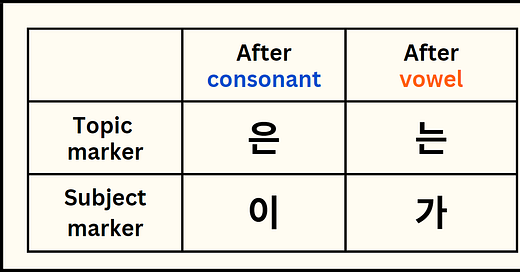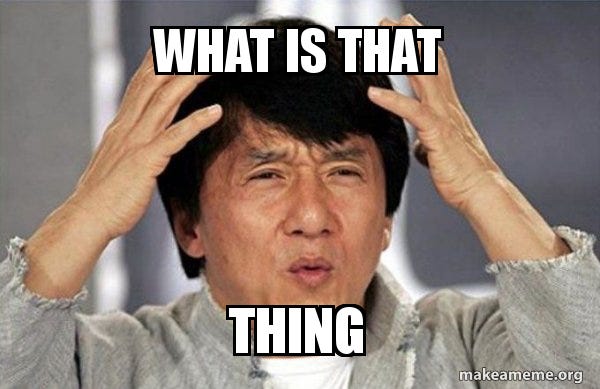👨🏻🏫What Is a Subject Marker?🤔
Understanding the difference between topic marker and subject marker
안녕! Hi, there!👋🏻
How was your week? I hope everything is going well for you😄. I can’t believe a quarter of the year has already passed! I’m sorry I haven’t responded to your comments from last week’s lesson, but I’ll get it done asap.
Next Saturday, I’ll be visiting home in Vancouver and I’ll get to hang out with my lovely princess, Haru🐶! You will see me posting a series of Instagram stories of Haru soon, so watch out😜!
Also, I’ll be going on my 2-week trip to Taiwan at the end of the month and I’m getting really excited for it. I’ll be going all around the island and I plan on documenting my trip with a GoPro (which I have to buy) and share it with you guys. So, I may not be able to write lessons for a couple of weeks but I’ll still try and write something while I’m away. Do you have any travel plans this year🛫? Maybe to Korea? Share in the comments!
Introduction to the subject marker
Last week, we looked at the topic marker and learned that it serves the purpose of setting the topic of the conversation and it can remain omitted until there is a topic change.
Some of you made a mistake adding a wrong topic marker to the subject. Remember, 은 is attached to a consonant ending subject and 는 is attached to a vowel ending subject.
Today, we are going to look at something called the subject marker. As a matter of fact, a lot of Korean learners struggle understanding the difference between the topic marker and the subject marker because of how similar these two Korean markers are:
They are both attached after the subject of a sentence
They both aren’t translated into English
As a result, Korean learners are always confused which marker to use when they try to speak Korean. And in fact, it is not so straightforward to explain the difference and give you a simple and perfect formula that tells you which one to use! But, there is no need to get discouraged at all as it takes quite a bit of time to experience that “aha moment” when things actually start clicking. So, I’m going to gradually and systematically reinforce your understanding of these markers as we move forward.
So, what is a subject marker?
Well, it’s got to be different from the topic marker obviously. Therefore, the subject marker does not set or change the topic of a conversation.
The definition of a subject marker says that it is a particle that indicates the subject of a verb. This probably doesn’t sound very clear, does it? At least when I saw this definition, I wasn’t instantly able to understand what it meant. Well, before I explain more on this, let’s have a look at how the subject marker is used first.
We had two different options for the topic marker depending on the last letter of the subject, Remember?
Attach 은 when the subject ends in a consonant
Attach 는 when the subject ends in a vowel
The exact same thing happens with the subject marker too!
Attach 이 when the subject ends in a consonant
Attach 가 when the subject ends in a vowel
Therefore, there are two markers for each kind:

So, going back to the definition of the subject marker stating that it marks the subject of the verb… let me elaborate on this. We all know that a verb is someone or something that is doing the action in a sentence and this type of verb is called an action verb. In fact, there was another kind of verb in Korean, do you recall from one of the previous lessons?
It was called… a descriptive verb!
A descriptive verb looked like an adjective in English like 예쁘다 “to be pretty’, 맛있다 “to be delicious/tasty”, 좋다 “to be good”, and so on. Consequently, we could have two different kinds of subject:
the subject of an action verb indicating who or what is doing the action
the subject of a descriptive verb indicating who or what is being described
Let’s have a look at an example:
김치는 제 어머니가 만들어요. ➝ My mother makes Kimchi.
김치: kimchi, 제: my, 어머니: mother 맛있다: to be delicious
At the beginning of the sentence, what is the first thing we see? A subject with a topic marker! We see a topic marker 는 after the subject Kimchi, so the sentence starts with “As for Kimchi…” setting it as the topic of this conversation. Then, we see a subject marker 가 attached to 제 어머니, because “my mother” is the person, or the subject by the definition, that is doing the verb which is making the Kimchi. Therefore, now we can see what the definition was trying to tell us—by adding the subject marker 가 after 제 어머니, you are letting the listener know that it is your mother who makes Kimchi.
Topic marker vs Subject marker
Because both the topic marker and the subject marker can be put in the same place in a sentence, what happens when you write two exactly same sentences where the only difference is the marker. Have a look:
지민 씨는 부산 사람이에요.
지민 씨가 부산 사람이에요.
지민: Jimin 부산 사람: a person from Busan 이다: to be
As I’ve mentioned previously, these markers don’t really get translated. Both of the sentences would mean the same that Jimin is from Busan. Let me give you an easy tip where you can easily figure out which marker to go with:
A topic marker emphasizes what comes after the subject of the sentence
A subject marker emphasizes the subject
“지민 씨는 부산 사람이에요.”
In this sentence, the topic marker 는 was used, so it must be emphasizing what comes after which is “부산 사람이에요” meaning that he is from Busan.
“지민 씨가 부산 사람이에요.”
On the other hand, the subject marker 가 was used in this sentence. So, it emphasizes the subject which is 지민.
Now, the important question you might want to ask is when do we want to emphasize the subject or what comes after the subject? Consider the following questions:
Where is Jimin from?
Who is from Busan?
If you think about the answers to these two questions, you will know which marker you want to use in your sentence.
To answer the question #1, the questioner would like to know where Jimin is from, so Busan is the key information for this question. Thus, you would want to say “지민 씨는 부산 사람이에요.”
But to answer the question #2, the questioner knows someone is from Busan but doesn’t know who the person is. In this case, the name of the person who is from Busan will be the key information the questioner is looking for, thus you would want to say “지민 씨가 부산 사람이에요.”
That’s it for today!
I would like to give you a little homework. Try and write a sentence using both topic and subject marker saying “As for me, K-pop is good” or “As for me, K-drama is good” depending on what you like more😁. These sentences are literally written so that it’s easier for you to try and write but they would mean closer to “I like (or prefer) K-pop” or “I like (or prefer) K-drama”.
Here are the words you need:
저: I or me
K-pop: 케이팝
K-drama: 한국 드라마
to be good: 좋다 (You need to conjugate this verb to be used in your sentence!)
Thank you very much for always engaging yourself in my lessons🙏🏻!
Have a great Sunday!
담에 또 봐!💙
If you need to learn the Korean alphabet and how to read Korean, consider purchasing my e-book here: Korean e-book: Read and Write Hangul in a Day





안녕!
저는 케이팝이 좋아요! 😄
안녕!
저는 케이팝이 좋아요. ☺️🎤🎶